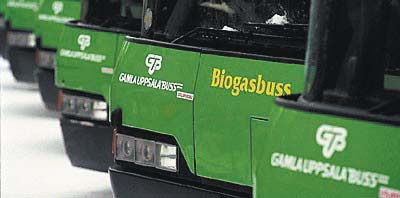| 2005 |

|
YEAR BOOK |
Cork Institute of Technology
|
Biomass, biogas, biofuels and bioenergy
|

Biomass offers opportunities to reduce reliance on fossil fuel. Biomass may be used as a source of electricity, as a source of heat or as a transport fuel. The technologies are mature; the pertinent issue is which technology to adopt.

In Sweden biogas is converted to a transport fuel by scrubbing out non-methane gases. Typically 1Nm 3 of biogas will replace 0.6 litres of petrol. In April 2005, 1 litre of petrol costs approximately �1; thus biogas may generate a revenue of �0.47/Nm 3 (VAT at 21%). In terms of electricity production, 1Nm 3 of biogas will generate 2kWh of electricity which will generate a revenue of �0.14 (allowing �0.07/kWh from biogas). A significant revenue advantage (�0.33/Nm 3 ) is available in utilising biogas as a transport fuel in Ireland rather than as a source of electricity.
If a transport fuel is generated from biogas, electricity must be imported from the grid to satisfy electric demand (pumps, mixers etc.). This parasitic demand is significant. In Sweden the carbon dioxide production per unit of electricity is low; electricity is produced from a mix of sources with a significant contribution from green sources. This is not so for Ireland where electricity is produced predominantly from oil and coal. A greenhouse-gas analysis highlights significant emissions in an Irish context compared to the Swedish situation. The solution to this is either to burn some biogas on site to generate the parasitic electrical demand with associated reduction in transport fuel produced, or to import green electricity.
The research group (WERG) showed that the organic fraction of municipal solid waste (OFMSW) proved to be a more economic source of biogas than agricultural slurries. This is due to the dilute nature of slurries. Also of issue is the gate fee; current landfill charges are as high as �240/t in Cork. The biogas plant may generate significant revenues by imposing a fee for accepting OFMSW.
The research group (WERG) undertook analysis of ethanol production from sugar beet and newspaper. In an Irish context biogas was shown to be a cheaper fuel.
The Biofuels Directive stipulates that EU member states must ensure that a minimum proportion of biofuels and other renewable fuels are placed on their markets. It establishes reference values for the minimum proportion of 2% by the 31 December 2005 and 5.75% by 31 December 2010. Studies undertaken by the research group (WERG) indicate that biogas could meet 1% of transport fuel requirements while ethanol could meet 5.7%.
The Landfill Directive stipulates that by 2016, 65% of the quantities of biodegradable waste landfilled in 1995 must be diverted from landfill. The diversion route includes composting or anaerobic digestion. If biogas produced from digestion of OFMSW is to be utilised as a transport fuel in Ireland it must be more economic than composting. An analysis by the research group (WERG) showed that digestion of OFMSW was more economic than composting at levels in excess of 20,000tpa if the biogas was used to displace petrol and no excise duty was charged (allowed by the Biofuels Directive). This equates to the waste generated by 100,000 persons.
In Dublin and Cork (populations in excess of 100,000) the organic fraction of municipal solid waste should be digested. The produced biogas should be scrubbed and utilised as a transport fuel. In Linkoping, Sweden, (population 130,000) biogas is used to fuel 60 buses. The research group (WERG) has shown that the produced biogas from Cork would feed the demand of the Cork bus fleet.
Future plans of the research group include examining the optimal method of generating combined heat and power from biomass in an Irish context.
Contact: Dr Jerry D Murphy,
Department of Civil, Structural and Environmental Engineering,
Cork Institute of Technology, Cork;
Tel + 353 21 4326745 E-mail: [email protected] ;